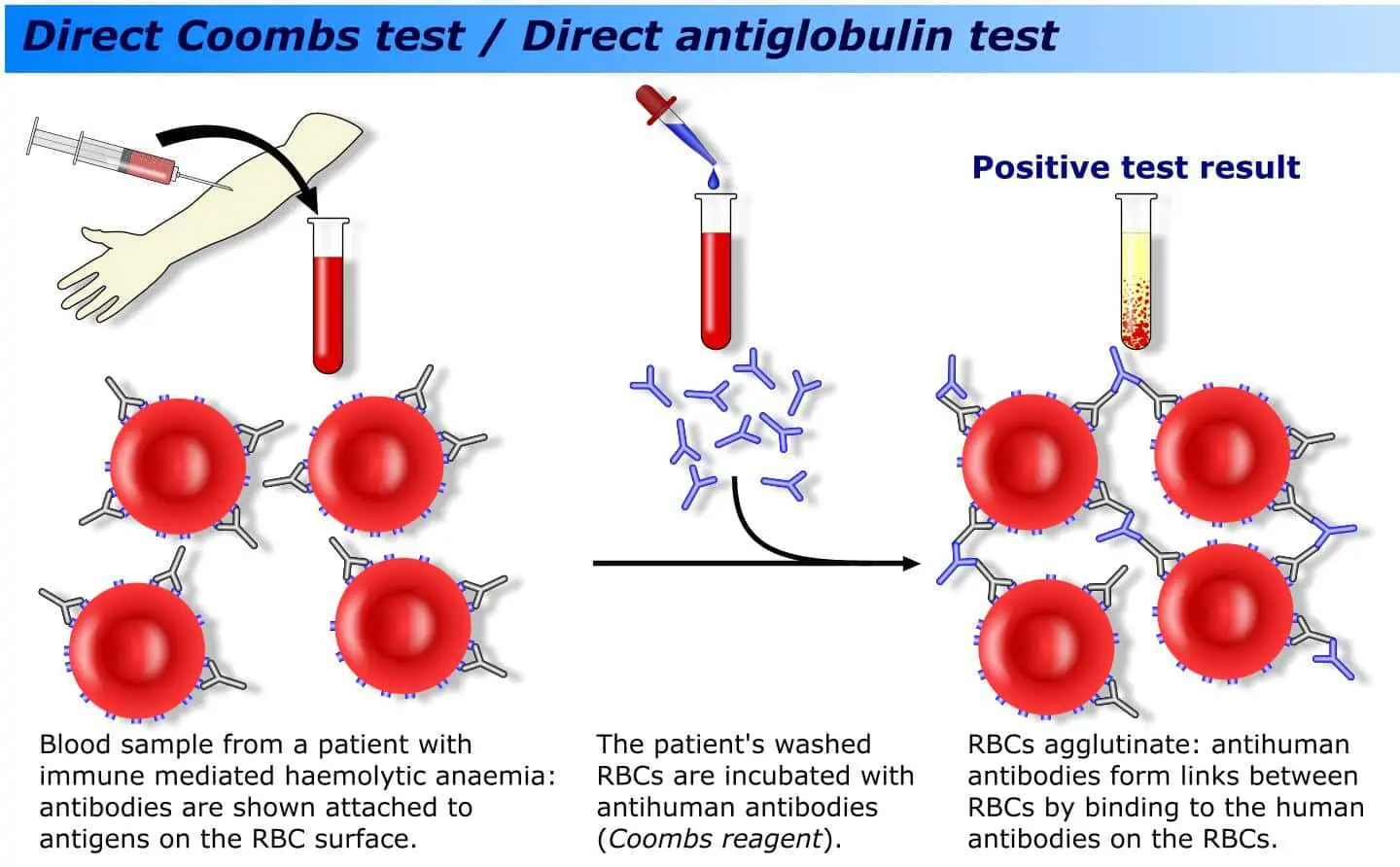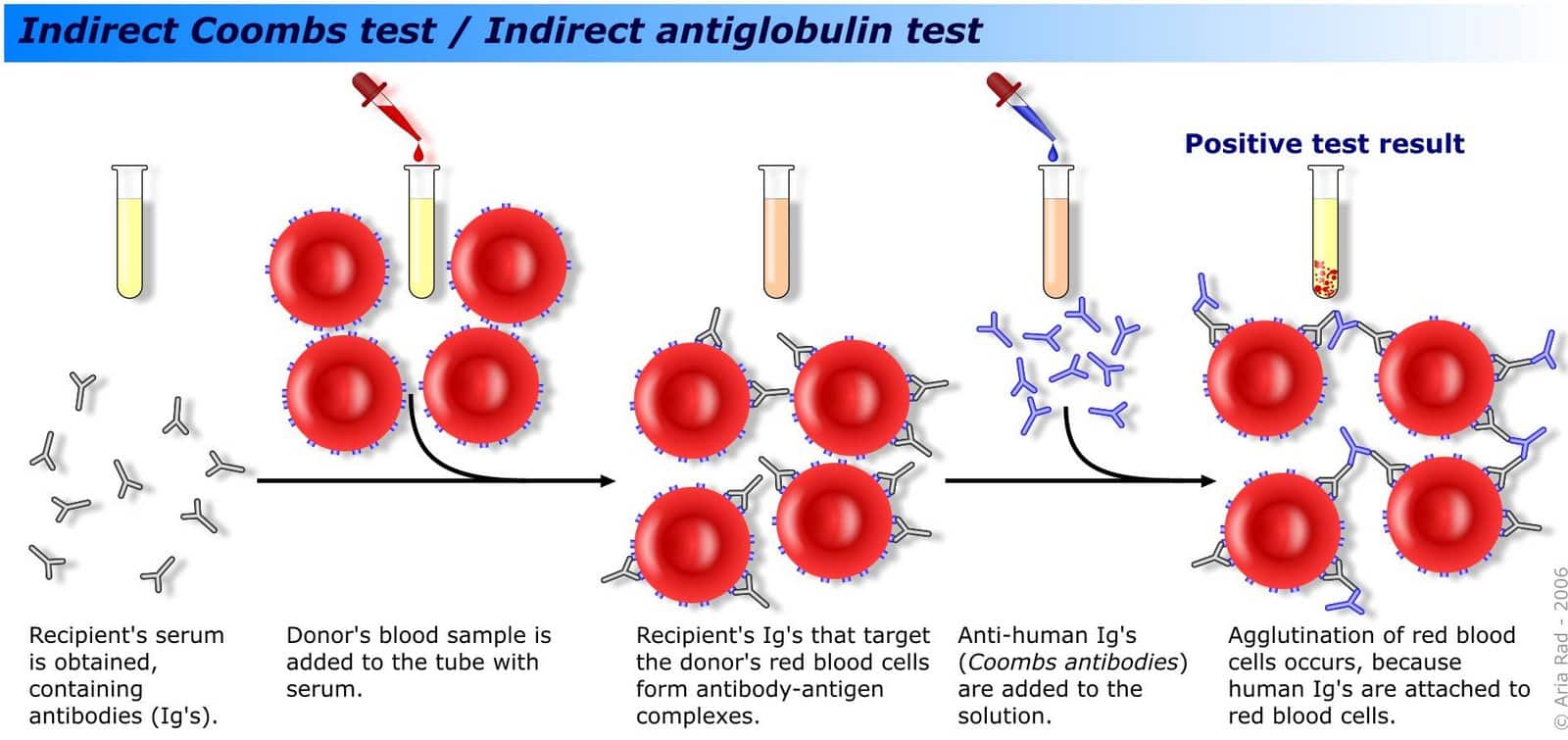The Coomb’s test (also known as Antiglobulin Test or AGT) refers to two clinical blood tests used in immunohematology which are done to find certain antibodies that cause autoimmune haemolysis of red blood cells (erythrocytes). The two types of Coombs tests are:
- Direct Coombs test
- Indirect Coombs test
Principle of Coombs Test
In certain diseases or conditions, an individual’s blood may contain IgG antibodies that can specifically bind to antigens on the red blood cell (RBC) surface membrane. Red cells coated with complement or IgG antibodies do not agglutinate directly when centrifuged.
These cells are said to be sensitized with IgG or complement. In order for agglutination to occur an additional antibody, which reacts with the Fc portion of the IgG antibody, or with the C3b or C3d component of complement, must be added to the system.
Because antibodies are gamma globulins, an antibody to gamma globulin can form bridges between red cells sensitized with antibody and cause them to agglutinate.
Direct Coombs Test
The direct Coombs test (also known as the direct antiglobulin test or DAT) is used to detect if antibodies or complement system factors have bound to RBC surface antigens in vivo.
A blood sample is taken and the RBCs are washed and then incubated with antihuman globulin. If this produces agglutination of RBCs, the direct Coombs test is positive, a visual indication that antibodies are bound to the surface of red blood cells.
This is the test that is done on the newborn’s blood sample, usually in the setting of a newborn with jaundice. The test is looking for “foreign” antibodies that are already adhered to the infant’s rbcs, a potential cause of hemolysis.
Procedure :
- Prepare 5% cell saline suspension of the cells to be tested.
- Label 3 tubes as T, PC and NC.
- In the tube labeled as T (Test), take 2 drops of 5% saline cell suspension to be tested.
- In the test tube labeled as PC (Positive control), take 1 drop of anti D sera and 1 drop of Rh +ve pooled cells.
- In the test tube labeled as NC (Negative control), take 1 drop of normal saline and one drop of Rh +ve pooled cells.
- Add 2 drops of Anti human globulin to each of the tubes.
- Mix well and centrifuge for 1 minute at 1500 rpm.
- Resuspend the cells by gentle agigation and examine macroscopically and microscopically for agglutination.
Indirect Coombs Test
The indirect Coombs test (also known as the indirect antiglobulin test or IAT) is used to detect in-vitro antibody-antigen reactions. It is used to detect very low concentrations of antibodies present in a patient’s plasma/serum prior to a blood transfusion.
In antenatal care, this test is used to screen pregnant women for antibodies that may cause hemolytic disease of the newborn. The IAT can also be used for compatibility testing, antibody identification, RBC phenotyping, and titration studies.
Procedure :
- Label 3 tubes as T, PC and NC.
- In the tube labeled as T (Test), take 2 drops of test serum.
- In the test tube labeled as PC (Positive control), take 1 drop of anti D serum.
- In the test tube labeled as NC (Negative control), take 1 drop of normal saline.
- Add one drop of 5% cell saline suspension of pooled O Rh +ve cells in each tubes.
- Incubate all the tubes at 37°C for 1 hour.
- Wash the cells 3 times with normal saline.
- Add 2 drops of Anti Human Globulin to each tube.
- Keep for 5 minutes and centrifuge at 1500 rpm for 1 minute.
- Resuspend the cells and examine macroscopically as well as microscopically for agglutination.
Interpretation
If the blood coagulates, it can be concluded that the patient’s red blood cells have been bound by (his/her own) immunoglobulins. Of course, this isn’t the normal state of affairs, and implies that the patient is experiencing an autoimmune haemolysis of his/her red cells.



thank you about this information but lack mor such as direct and in direct causes positive
and my quatsion whay use o positive ( fresh ) in indirect coombs test with my best regard
Thank you for this concise explanation of Coombs test.
Would definitely love to enjoy your blog too.
Very nice collection
Thanks for this
Good work